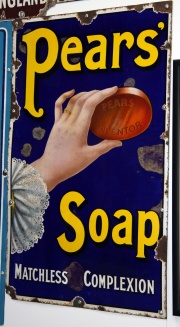A. and F. Pears


Pears of 71-5 New Oxford Street, London.
Pears transparent soap is an old brand of soap, first produced commercially in 1789 by Andrew Pears at a factory just off Oxford Street in London, England. It was the world's first transparent soap.
Pears began to experiment with soap purification eventually managed to produce a gentle soap based on glycerine and other natural products. The clarity the soap gave it a novel transparent appearance which provided a marketing advantage. To add to the appeal, he gave the soap an aroma reminiscent of an English garden.
1835 His grandson Francis Pears joined the business and created the company A. and F. Pears Ltd. The company operated from premises just off Oxford Street, London.
1838 Andrew Pears retired, leaving Francis in charge of the company.
1841 Listed as 'Pears, Andrew, of 55 Wells Street, Oxford Street, wholesale and retail perfumer' [1]
1851 Awarded the prize medal for soap at The Great Exhibition.
1852 Listed as 'Pears, Andrew and Francis, soap refiners, 91 Great Russell Street, Bloomsbury. [2]
1861 The company consisted of Francis employing one man and one boy. [3]
1862 Production of the soap moved to Isleworth, and three years later Francis' son, Andrew Pears, Junior, joined the company as joint proprietor and ran the factory, whilst Thomas ran the head office in London.
Francis' son-in-law Thomas James Barratt, sometimes referred to as the father of modern advertising, eventually took over the firm.
Under the stewardship of Barratt, the A. and F. Pears Ltd company initiated a number of innovations in sales and marketing. According to Unilever records, Pears Soap was the world's first registered brand and is therefore the world's oldest continually existing brand.
1881 Employing 106 people [4]
1892 The company was registered on 28 May, to take over the business of soap manufacturers of the firm of the same name. [5]
1894 The company's most famous trademark was registered. The Bubbles advertisement was based on an earlier painting of curly-headed boy blowing a soap bubble. The painting was originally called A Child's World.
Through the work of Thomas Barratt Pears Transparent Soap became a major product both in the UK and abroad.
1914. The company became part of Lever Brothers and moved production to Port Sunlight in north west England.
From the late nineteenth century, Pears soap was famous for its marketing, masterminded by Barratt. Its campaign using Millais's painting Bubbles continued over many decades. As with many other brands at the time, at the beginning of the 20th century Pears also used their product as a sign of the prevailing European concept of the "civilizing mission" of empire and trade, in which the soap stands for progress.
Between 1891 and 1925, Pears issued their now famous Annuals, now highly collectible.
From the early 20th century Pears was famous for the annual "Miss Pears" competition in which parents entered their children into the high-profile hunt for a young brand ambassador to be used on packaging and in consumer promotions. Many Miss Pears subsequently entered acting or modelling.
The concave shape of the soap is formed by shrinkage while the soap is drying, and is not due to deliberate moulding. Users of the soap use the concave area to dissolve the last slither of the previous bar of soap. Pears Soap is often used by the elderly for its skincare properties.
See Also
Sources of Information
- [1] Wikipedia
- Trademarked. A History of Well-Known Brands - from Aertex to Wright's Coal Tar by David Newton. Pub: Sutton Publishing 2008 ISBN 978-0-7509-4590-5



















































